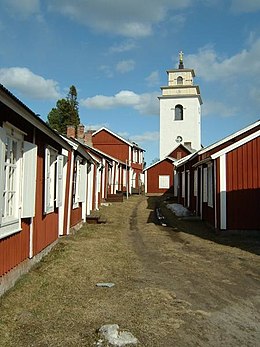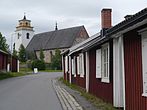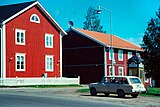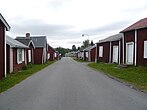Gammelstad Church Town
| UNESCO World Heritage Site | |
|---|---|
 Gammelstad Church Town | |
| Location | Gammelstaden, Luleå Municipality, Norrbotten County, Sweden |
| Criteria | Cultural: (ii), (iv), (v) |
| Reference | 762 |
| Inscription | 1996 (20th Session) |
| Area | 16.402 ha (40.53 acres) |
| Buffer zone | 243.474 ha (601.64 acres) |
| Website | www |
| Coordinates | 65°38′46″N 22°01′43″E / 65.64611°N 22.02861°E |
Gammelstad Church Town (Swedish: Gammelstads kyrkstad) is a UNESCO World Heritage Site situated in Gammelstaden near the city of Luleå, Sweden, at the northern end of the Gulf of Bothnia. It is the best preserved example of a type of town that was once widespread throughout northern Scandinavia. As Church Village of Gammelstad, Luleå, it was listed as a World Heritage Site in 1996.
The town is located about 10 kilometers upstream the Lule River. At its centre is the 15th-century Nederluleå Church surrounded by 424 wood-built houses. The houses were only used on Sundays and during religious festivals to accommodate worshipers from the surrounding countryside who could not return home the same day because of the distance and difficult traveling conditions.[1]
Because the buildings are built from timber, regular maintenance is required to prevent rot; surveys have been carried out to document the extent of existing rotting, and snow is cleared regularly during the winter.[2]
Gallery
-
Gammelstad church town near Lulea
-
World Heritage Site Gammelstad near Luleå
-
Gammelstad town map hoarding at the entrance
-
Gammelstad town map
References
- ^ Fast, April; Thomas, Keltie (2004). Sweden: The Culture. Crabtree Publishing Company. p. 20. ISBN 077879329X.
- ^ Kaslegard, Anne (2011). Climate Change and Cultural Heritage in the Nordic Countries. Nordic Council of Ministers. p. 16. ISBN 9289321954.










